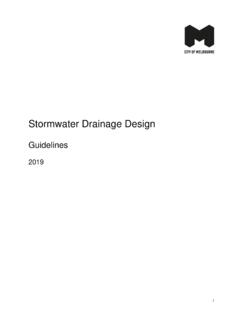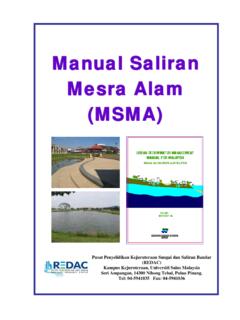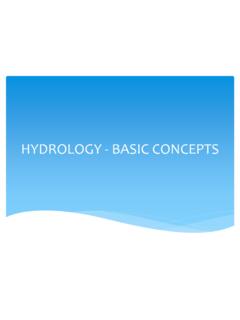Transcription of Assessing attenuation storage volumes for SuDS
1 Fact sheet March 2014 1 Assessing attenuation storage volumes for suds The author Anthony McCloy, Managing Director of McCloy Consulting, is a Chartered Civil Engineer with expertise in water, hydrology, flood risk assessment and suds design . His experience to date includes analysis of drainage systems using various hydraulic modelling packages and development of guidance for Local Authorities. As a leading specialist in the field of sustainable drainage , Anthony has been a key tutor for the (CIRIA) National suds training workshops since 2006 and resides on the Project Advisory Group for the suds Manual update.
2 Introduction Flooding is a primary concern across many parts of the UK and Ireland. Whenever catchment flows exceed the capacity of the receiving watercourse, the excess water is conveyed or stored in the floodplain. Whenever a site is developed the rate of runoff from the site significantly increases. In order to protect the floodplain we endeavour to control runoff rates form a development to match that of predevelopment (Greenfield runoff ) rates. attenuation storage is required to hold back this volume of water to the required rate.
3 However, as we cover a development site with hard surfaces we also lose the potential for water to percolate into the ground. As a floodplain has a finite volume , we mitigate by holding back the additional volume of runoff until floodwaters have abated. The retention of this additional volume of runoff for a longer period of time is generally referred to by the industry as Long Term storage . The process of how attenuation storage volumes are derived is generally not well understood across the various disciplines who are involved in the design of suds schemes.
4 Many of us rely on spreadsheets, modelling software, published maps and charts or a helpful colleague to provide us with the volumes and flow we require to facilitate our suds design . To deliver well considered and designed schemes it is important that all disciplines, not just hydraulic modelling specialists, have a broader appreciation of the attenuation calculation process, if only to ensure they can act as an intelligent client, or ask the right questions. This fact sheet does not seek to rewrite hydraulic manuals. However, a number of aspects relating to the estimation of flows and volumes for suds design have been considered from a less-technical perspective than found in manuals.
5 It is hoped that this information will be understandable to a wider range of members of the suds design / suds Approval Body (SAB) evaluation team. It should also provide the SAB team with an increased understanding to assist with the Anthony McCloy outlines the approaches to providing suds attenuation volumes , and highlights some important considerations when approaching attenuation designs or evaluations. Fact sheet March 2014 2 assessment of uncomplicated schemes and identify when they may need to seek further advice from specialists. The fact sheet covers the following aspects of attenuation design : Understanding fundamentals Making allowance for interception losses Selecting an appropriate Coefficient of volumetric runoff (Cv) Expressing attenuation storage volumes as m3 for each m2 of developed site area Approaches to determining storage volumes Understanding the fundamentals of attenuation storage design Prior to undertaking storage calculations it is important to understand a few of the basics of attenuation design .
6 A few pointers are noted as follows: Water flows downhill! Levels of the site are vital and will be affected by approaches to managing volumes of water on the surface of the site. For flow rates to be attenuated / regulated, a flow control structure is required. This control could be an orifice, a weir or a more complex vortex flow control arrangement. It s likely to be more cost effective to store volumes of water across the site within each sub catchment as part of the suds management train, thus maximising the site potential, than storing at one location prior to discharge.
7 Consequently, a number of flow controls are required to control flows and provide storage volumes along the management train. Anyone designing or evaluating attenuation volumes should know what ball park volumes to expect prior to the calculation (or evaluation). This ensures that gross errors or model stability issues can be easily identified. If and when the specified design criteria for flows and volumes are exceeded, attenuation storage will overtop. Similarly, storage will not perform to design standards if any part of the system becomes blocked.
8 Designing for exceedance or blockage is as, if not more, important as determination of exact storage volumes . suds are designed to mimic natural drainage processes; therefore an understanding of natural drainage processes should be fully appreciated by the designer. Don t overlook the linkage between stored volumes of water and the other aspects of suds such as water quality and amenity benefit. storage volume areas should be multi-functional and should be at or near the surface wherever possible. Don t expect exact answers from the calculation process, it is a usable approximation that can provide acceptable solutions for design .
9 Most of the inputs are based on statistics and calibration factors; therefore we can only ever achieve an approximation of how the system will behave in reality. The results of calculations and modelling need to be used alongside professional judgement to provide the design . Interception losses It is generally considered that about 50% of each year s total rainfall occurs in events which are less than 5mm in depth. In a natural catchment, the first 4mm to 5mm of rainfall is lost due to natural processes such as soakage into the topsoil, infiltration, evaporation and transpiration (combined this is referred to as evapotranspiration); and therefore does not result in runoff .
10 Source control techniques such as green roofs, permeable pavements and swales can be provided to replicate natural catchment processes. provides a storage evaluation tool which can provide estimates for flows and volumes . Fact sheet March 2014 3 In calculation terms, where Source Controls are provided, an allowance can be made for interception losses by reducing rainfall depths by 5mm when deriving runoff generated ( inflow to the attenuation storage calculation). Selecting and appropriate coefficient of volumetric runoff (Cv) The specification of a runoff coefficient attempts to represent the volume of flow from a particular surface.







